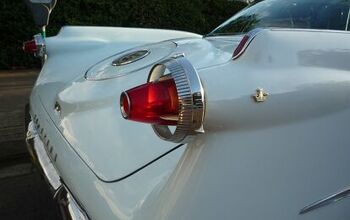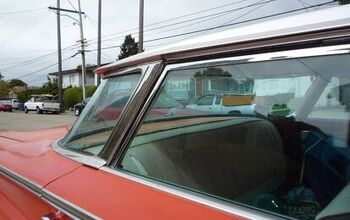Curbside Classic: 1960 Comet

If this goofy-assed little car showed up at your premium brand’s doorstep and told you it was an unwanted orphan, would you let it in? And keep it as a foster child, or adopt it as your own? That’s the scenario Mercury found itself in with the Comet. And true to form, Mercury waffled.
The Comet was planned as a compact Edsel, but when that expensive little venture went belly up, it needed a home. Mercury let it into its dealers, but not branded as a Mercury, just Comet. After all, Mercury had a finely-honed brand identity to protect: uninspired, overwrought, wallowing Buick wanna-be barges that sold poorly. It wasn’t about to let the Comet sully that.
Was Mercury dutifully obeying Robert Farago’s oft-repeated maxim against eroding a brand by extension? Perhaps. Mercury was in the depths of its perpetual self-identity crisis, which was exacerbated by the whole Edsel debacle. Ford wanted Mercury to aim up even higher, at Buick; thus the Comet solution. But two significant events changed Mercury’s mind.
First, Buick came out with its own compact Special in 1961.
In GM’s heyday in the 1920’s, when the various divisions each decided to expand and fill the gaps between them, their off-shoots were sold under new names: Cadillac spawned LaSalle, Buick birthed Marquette, Olds created Viking, and Pontiac itself was an offshoot of Oakland. GM has quite the cemetery of failed brands. But GM’s decision to let Pontiac, Olds and Buick have compacts in 1961 changed the rules forever. And soon there was the addition of premium Chevys like the Monte Carlo and Caprice. The GM brand muddle was in full swing.
The second thing that changed Mercury’s mind was that the Comet sold quite well for the first couple of years, during those compact boom years. The real Mercuries didn’t. In fact the Comet outsold the big Mercs almost two-to-one in ’61. Probably explains best why the Comet became a genuine Mercury in ’62.
The Comet was a stretched and re-skinned Falcon. Actually, only the sedans rode on a lengthened wheelbase and had that loopy rear end. For cost-efficiency’s sake, Comet wagons were thinly disguised Falcons with a Comet front clip. Since Comets were planned to be Edsels, some parts still carried the “E” prefix. And that rear taillight lens looks mighty similar to those on the 1960 Edse l.
Except for the taillights and finlets, the Comet’s styling was actually ahead of the whole Ford clan in 1960. It almost perfectly predicts the ’62 Fairlane and Meteor twins, as well as Ford’s general styling trend in the first half of the sixties. Of course, it wears that ’58 T-Bird roof proudly, like so many other Fords of the era. And by 1962, the Comet’s tail entered a more mainstream galaxy.
Except for that longer wheelbase, the Comet shared its mechanicals with the Falcon. That meant only one engine for the Comet’s abbreviated first year: the 144 cubic inch (2.5 liter) six that packed all of 90 hp (gross) at 4200 rpm. That would be about 75 of today’s (net) ponies. That made it the feeblest of the semi-upscale new compacts.
The two-speed automatic strangled that herdlet of ponies dead in their tracks. Good thing the slightly stronger 170 cubic inch came along in ’61, as well as the little 260 V8 in ’62. But with a stick and a glass-pack muffler like this one, the little six at least sounds like it’s making half-way decent forward progress.
There’s a distinctive tone to these small Ford sixes. If they’re wheezing through the stock muffler, it’s very nasal, as in dire need of an antihistamine. With a less restrictive muffler, it reminds me of European and other vintage small displacement in-line sixes, like the old Opels, the Triumph six, and others of the period. It’s a pleasant, roarty throb, but smooth and obviously harmless. We’ll indulge in the joys of inline sixes more in the future.
Speaking of European influence, the Comet and Falcons actually had a four-speed column-shifted stick option for a couple of years starting in 1961. It was sourced from the British Consul or Zephyr, and was a pretty rare bird. Four-on-the-trees were almost unheard of in the US. Oddly enough, according to one source, last week’s GMC Handi-Van and its twin Chevy Van were supposedly available with a column-shifted T-10 four speed in 1968. Weird. Can anybody confirm that, or know of any other US four-on-the-trees?
Like its namesake, the Comet’s sparkle was short lived. Once it earned itself the Mercury name, it became a slacker, and sales began a long decline. Maybe the Mercury name is a jinx. The ill-fated mid-sized Meteor, which appeared in 1962, didn’t help. It was a lightly reskinned Fairlane, but because the Comet was already a lengthened Falcon, it was almost mid-size itself. The Comet and Meteor were almost indistinguishable, and it all devolved into a typical Mercury muddle. It was not the winged god that gave Mercury its name; it was the mineral: it’s impossible to give it definition, and it’s deadly.
For a few years starting in 1964, Mercury tried to inject some performance vitality into the Comet, including some wild factory-supported drag racing Cyclones. Amusing wheelie machines and cult favorites, but they didn’t really help sell the metal on Mondays. By 1966, Comet morphed into a mid-sized car, which then became the Montego. And by 1971, the Comet’s highly irregular orbit was completed, and it suddenly reappeared as a badge-engineered Maverick. Wish me luck on finding one of those. And if history repeats itself, maybe we’ll see a 2011 Comet badge-engineered from the coming new Focus, if Mercury is still around by then.

More by Paul Niedermeyer
Latest Car Reviews
Read moreLatest Product Reviews
Read moreRecent Comments
- Formula m Same as Ford, withholding billions in development because they want to rearrange the furniture.
- EV-Guy I would care more about the Detroit downtown core. Who else would possibly be able to occupy this space? GM bought this complex - correct? If they can't fill it, how do they find tenants that can? Is the plan to just tear it down and sell to developers?
- EBFlex Demand is so high for EVs they are having to lay people off. Layoffs are the ultimate sign of an rapidly expanding market.
- Thomas I thought about buying an EV, but the more I learned about them, the less I wanted one. Maybe I'll reconsider in 5 or 10 years if technology improves. I don't think EVs are good enough yet for my use case. Pricing and infrastructure needs to improve too.
- Thomas My quattro Audi came with summer tires from the factory. I'd never put anything but summer tires on it because of the incredible performance. All seasons are a compromise tire and I'm not a compromise kind of guy.





































Comments
Join the conversation
That Comet has the craziest trunk and rear I have ever seen. It looks like something from Mayberry. And it may be off topic, but jpcavanaugh, I would love to hear about the Fleetwood
I think this little car looks cool in that color. I always kinda liked the styling, which I'm sure helped sell the car in those first couple of years. The first chrysler A bodies were odd looking, but that would change by 63. The chrysler compacts had it all over the ford compacts and the nova and it's siblings in the engineering department. The suspension, brakes, engines and drivelines were far superior to the ford and gm offerings. I do love the looks of the comet, though, I even like the squinty slanted taillights. When I was growing up our neighbors down the street had a comet just like this one, it was a hideous shade of purple. Dunno whether or not it was a factory color. I remember it being a six cylinder by the flatulous sounds it made as it went down the street.